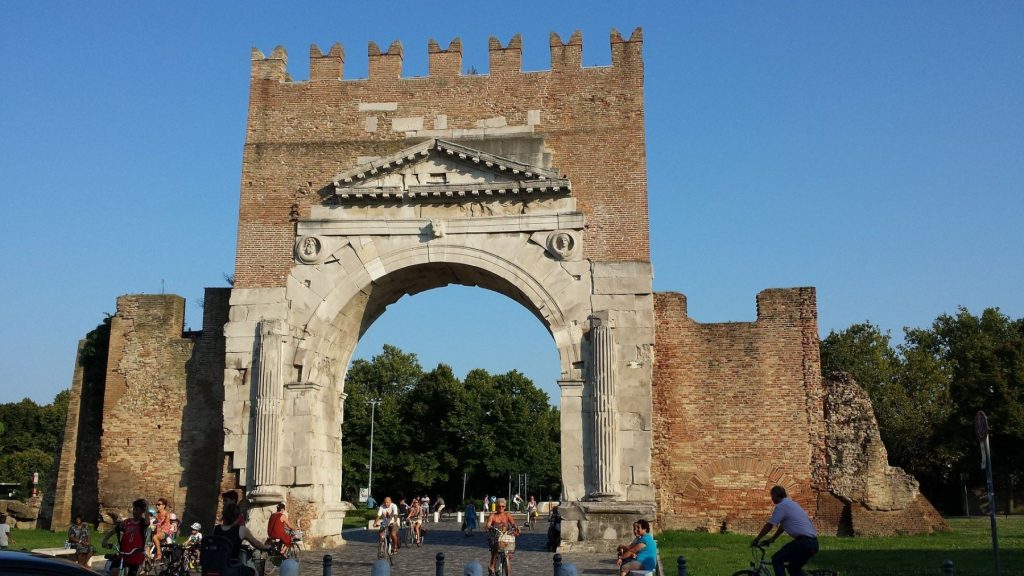Rimini is the hottest beach destination along the coast of the Emilia-Romagna region. Known for its endless stretches of fine, sandy beaches, restaurants and cafes, and nightclubs, it is both a family holiday destination as well as a party hub for youth.
Rimini: Art and History
Rimini is also so much more than just mare! Very few people realize that Rimini was once one of the most important Roman cities in northern Italy. The Ariminus river (now, the Marecchia) which empties into the Adriatic Sea became an important stronghold in third-century BC Rome as they defended their territory against the Gauls. From here, three major Roman roads also departed: the Flaminia, the Emilia, and the Popilia-Annia.

Rimini still holds some major Roman treasures that are must-sees when you visit- even if you’re on a beach holiday!
- Ponte di Tiberio: This bridge that spans the width of the Marecchia river was constructed over 2,000 years ago by Emperor Augustus and completed by Emperor Tiberius. It’s one of the most picturesque spots of the whole city.
- Arco di Augusto: Few people know that this is the oldest standing Roman arch in northern Italy dating to 27 AD! Part of the original city walls is still attached alongside of it.
- Piazza Tre Martiri: The Three Martyrs’ Piazza was originally believed to be the very piazza in which Giulius Cesar gave his famous speech. Later, the theory was disproved when it was discovered that it actually took place in Ravenna at the Rubicon river (hence the phrase “Crossing the Rubicon”). During Roman times, this piazza was the ancient forum and didn’t take on its present look until the 16th century. It’s also important to note that the piazza takes its name in memory of three young Italian partisans who were hanged by the Nazis in 1944. This is also where you’ll find the famous Torre dell’Orologio, or the Clock Tower, constructed in 1547.
- Domus del Chirurgo: Unearthed in 1989 by mistake, this “surgeon’s house” dates to the 2nd century AD. Over 150 medical and surgical instruments were found amongst the fantastic mosaics of the villa. You can visit the Domus, but much of what was found is now housed in Rimini’s museum- Il Museo della Città di Rimini– right next door.
- Porta Montanara/Porta Andrea: This gate to the city can be referred to by two names. Its two distinct openings allowed for simultaneous entry and exit into the city from the Marecchia Valley.
Other Sights in the Historic Center
Rimini’s Duomo, il Tempio Malatestiano, is an unusual, unfinished cathedral that takes its name from Malatesta, ruler of Rimini in the 15th century. Inside you’ll find frescoes by Piero della Francesca and a crucifix attributed to Giotto.
Piazza Cavour is considered the very heart of Rimini and is where you’ll find the majority of the shops, restaurants, and cafes. The famous fountain, Fontana della Pigna, sits at the very center and has been a central meeting point for locals for hundreds of years. The magnificent Palazzo dell’Arengo and Palazzo della Podestà are also here as well as the ancient Pescheria Vecchia (fish market) and the neo-classical Teatro Comunale.
As if all this weren’t enough, Rimini also has its own castle- Castel Sismondo. Located just steps away from Piazza Cavour, the majestic Sismond Castle even had Brunelleschi’s input during its construction in 1438. Today, what we see is only a portion of the original although it underwent a massive restoration project in 2018.
Make sure to stroll through the ancient fishing village neighborhood known as Borgo San Giuliano with its brightly-colored houses and beautiful murals.
Federico Fellini’s Rimini
Considered one of the greatest directors of all time, Federico Fellini was born in Rimini in 1920. His iconic films such as Amarcord, La Dolce Vita, 8 1/2, La Strada, Notti di Cabiria forever changed the world of cinema. In 2020, the city celebrated 100 Years of Fellini, and visitors today can take either guided tours or self-guided tours visiting all of the famous Fellini locations throughout the city. A museum entirely dedicated to cinema and Fellini himself was scheduled to be housed in the famous Fulgor Cinema but has not yet been completed.
Rimini’s Beaches
There are an astonishing 250 bathing establishments along the shores of Rimini. Many hotels also include the use of an umbrella and lounge chairs during your stay. Within the past two years, Rimini has also declared itself a cigarette smoke-free and plastic-free beach! There is loads of entertainment for all ages from beach volleyball, to group dancing and exercising, to entertainment for the little ones. Many sections are also dog-friendly in case you are traveling with your pet.

What’s more, when you visit Rimini you are just a short drive away from the famous hilltop villages of Santarcangelo, San Leo, and the Republic of San Marino!


